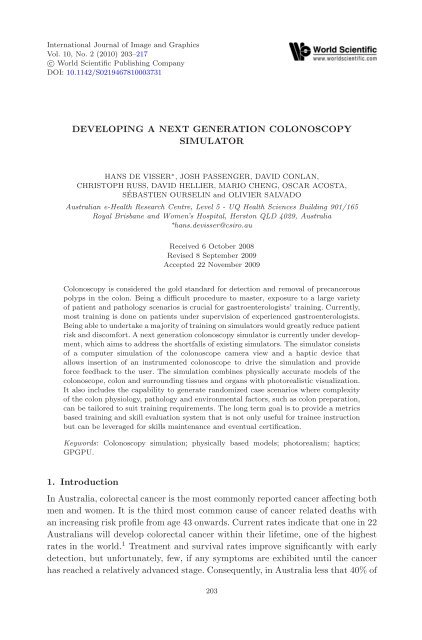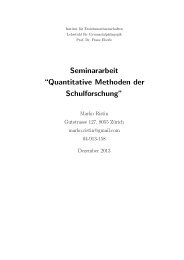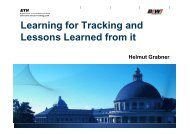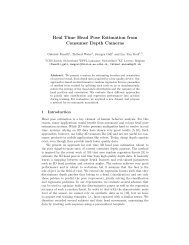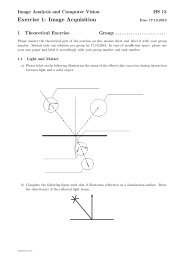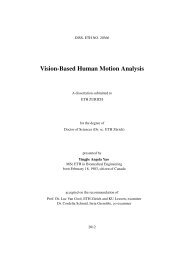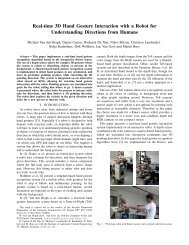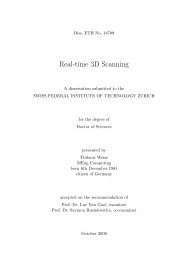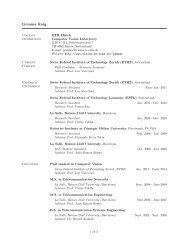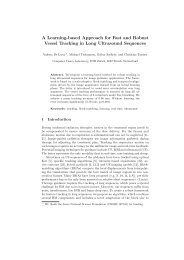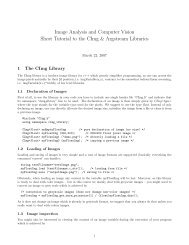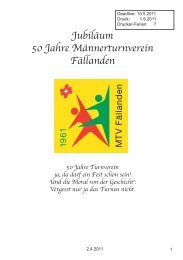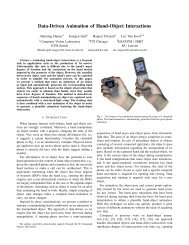DEVELOPING A NEXT GENERATION COLONOSCOPY ...
DEVELOPING A NEXT GENERATION COLONOSCOPY ...
DEVELOPING A NEXT GENERATION COLONOSCOPY ...
Create successful ePaper yourself
Turn your PDF publications into a flip-book with our unique Google optimized e-Paper software.
International Journal of Image and GraphicsVol. 10, No. 2 (2010) 203–217c○ World Scientific Publishing CompanyDOI: 10.1142/S0219467810003731<strong>DEVELOPING</strong> A <strong>NEXT</strong> <strong>GENERATION</strong> <strong>COLONOSCOPY</strong>SIMULATORHANS DE VISSER ∗ , JOSH PASSENGER, DAVID CONLAN,CHRISTOPH RUSS, DAVID HELLIER, MARIO CHENG, OSCAR ACOSTA,SÉBASTIEN OURSELIN and OLIVIER SALVADOAustralian e-Health Research Centre, Level 5 - UQ Health Sciences Building 901/165Royal Brisbane and Women’s Hospital, Herston QLD 4029, Australia∗ hans.devisser@csiro.auReceived 6 October 2008Revised 8 September 2009Accepted 22 November 2009Colonoscopy is considered the gold standard for detection and removal of precancerouspolyps in the colon. Being a difficult procedure to master, exposure to a large varietyof patient and pathology scenarios is crucial for gastroenterologists’ training. Currently,most training is done on patients under supervision of experienced gastroenterologists.Being able to undertake a majority of training on simulators would greatly reduce patientrisk and discomfort. A next generation colonoscopy simulator is currently under development,which aims to address the shortfalls of existing simulators. The simulator consistsof a computer simulation of the colonoscope camera view and a haptic device thatallows insertion of an instrumented colonoscope to drive the simulation and provideforce feedback to the user. The simulation combines physically accurate models of thecolonoscope, colon and surrounding tissues and organs with photorealistic visualization.It also includes the capability to generate randomized case scenarios where complexityof the colon physiology, pathology and environmental factors, such as colon preparation,can be tailored to suit training requirements. The long term goal is to provide a metricsbased training and skill evaluation system that is not only useful for trainee instructionbut can be leveraged for skills maintenance and eventual certification.Keywords: Colonoscopy simulation; physically based models; photorealism; haptics;GPGPU.1. IntroductionIn Australia, colorectal cancer is the most commonly reported cancer affecting bothmen and women. It is the third most common cause of cancer related deaths withan increasing risk profile from age 43 onwards. Current rates indicate that one in 22Australians will develop colorectal cancer within their lifetime, one of the highestrates in the world. 1 Treatment and survival rates improve significantly with earlydetection, but unfortunately, few, if any symptoms are exhibited until the cancerhas reached a relatively advanced stage. Consequently, in Australia less that 40% of203
204 H. De Visser et al.cases are currently detected early. 2 To address this problem, the Australian Departmentof Health and Ageing has set up a trial program which aims to improve earlydetection rates. This National Bowel Cancer Screening program 3 offers Australiansturning 50, 55 or 65 years of age, fecal occult blood tests (FOBT), which test forthe presence of blood in the stool. Positive FOBT results are generally referred for acolonoscopy. Not only does colonoscopy offer detection and treatment of colorectalcancer, it allows removal and biopsy of precancerous colonic polyps and flat lesions.Excised tissue can then be sent for identification and histological confirmation. Theprocedure involves the insertion of a colonoscope (Fig. 1) into a sedated patient’srectum, generally as quickly as patient comfort and safety allow. The gastroenterologistaims to insert the colonoscope until the tip reaches the cecum, the proximalend of the colon. It is then retracted slowly, and during this time, the colon isinspected closely for the presence of polyps and suspicious tissue. Unfortunately,colonoscopy is a difficult procedure to master with most training occurring on realpatients. Studies have shown an increased frequency of minor adverse effects associatedwith trainee procedures and a direct correlation between adverse effects andpatient reluctance to attend follow-up examinations. 4 Training costs for gastroenterologyfellows is high due to a reliance on high fidelity training settings and thelonger procedure times associated with trainee procedures. 5Provision of simulators for training surgical procedures has many benefits includingreduced risk to patients, reduced training costs, ability to train difficult and1 243Fig. 1. A standard Olympus CF-Q160AL colonoscope. The control dials (1) on the handle (2)are used to operate the deflectable tip (3). The umbilical (4) connects to the light source, monitorand air and water supply unit.
Developing a Next Generation Colonoscopy Simulator 205rare pathologies and the potential for off-patient certification. Unfortunately, existingcolonoscopy simulators rate fairly low for haptic and anatomical realism and donot provide a case variety with a level of difficulty to make them useful for anythingbut novice training. 6The project presented here aims to develop a next generation colonoscopy simulatorby targeting the deficiencies in existing simulators through dramatic improvementof 4 key features: case complexity, anatomical and physical realism, visualrealism, and haptic fidelity. Our long term goal is to provide a metric based trainingand skill evaluation system that is not only useful for trainee instruction butcan be leveraged for skills maintenance and eventual certification.2. MethodsThe simulator consists of two primary components: A computer generated virtualenvironment mimicking the view the gastroenterologist normally sees during acolonoscopy procedure and a haptic interface which allows the user to interact withthe virtual environment.The virtual environment is based upon a custom developed modular multithreadedsoftware framework 7 (Fig. 2) for surgical simulation, written in C++. Itis capable of running complex simulation scenes at frequencies of up to 1000 Hz.The framework is highly configurable and allows development of new componentsthrough a plug-in architecture.Colon shape data is extracted from patient abdominal CT scans (Fig. 3) andtwo surface meshes of each colon are generated. The first is a low resolution meshFig. 2. Our modular simulation framework allows integration of many components at hapticrates (300–1000 Hz).
206 H. De Visser et al.(a)(b)Fig. 3. Patient CT scans are processed to extract the colonic lumen (a) A patient CT scan(b) The extracted colonic surface.upon which a physically based model is based, which is solved at haptic rates(300–1000 Hz). The second is a high resolution visualization mesh capturing thedetail of the colonic surface and is mapped onto the physical model at renderingrates (30 Hz). 8 The physically based model of the colon is constrained by modelsof the surrounding tissue and organs, and deformed through the interaction withthe colonoscope model, which is controlled by the user via the haptic device. Toaccount for the large variety in patient anatomy and pathology, a case generatorhas been created to provide randomized scenarios sufficient to deliver a completetraining program to a high level of competence. Each step is described in moredetail in the following sections.2.1. Data acquisitionAbdominal CT colonography scans, courtesy of Dr. Richard Choi, VirtualColonoscopy Center, Walter Reed Army Medical Center, are processed using customsoftware to extract geometric models of the colonic lumen (Fig. 3). The acquisitionprotocol for the images included ingestion of contrast agents to improve the contrastof solid-stool and luminal fluid. Air and stool/fluid regions are labeled throughvoxel intensity thresholding and merged. The colon is identified manually and otherair filled structures are discarded. The surface of the raw binary colon image issmoothed and a marching cubes 9 algorithm is used to extract a high density surfacemesh. Successive Laplacian smoothing 10 and quadric decimation 11 filters areapplied until a high resolution surface mesh of an appropriate density is obtained,
Developing a Next Generation Colonoscopy Simulator 207balancing anatomical realism and rendering performance. A lower resolution meshis generated through further decimation of the high resolution surface mesh.2.2. VisualizationTexture coordinates for surface texturing and shading are required to obtain realistictissue rendering of the surface mesh. A novel technique for generation of surfacetexture coordinates 12 creates correspondences between the colon surface and thecolon centerline by tracing equipotential streamlines, generated by solving Laplace’sequation. 13–15 The process results in a surface mesh with smooth texture coordinateswhich exhibit minimal stretching or tearing artifacts.Realistic organ and tool visualization is obtained via an OpenGL GLSL shaderpipeline. 16 Triangular surface mesh texture coordinates are used to determine theposition of multiple textures on the mesh surface. These include blood vessels, Perlinnoise, mucous, pathology and normal mapping textures. Several render passes arerequired to create a complete scene comprising realistic organ and tool surfaces, softshadows and post-process lens effects including lens flushing and camera occlusionartifacts.2.3. Mesh mappingThe size and complexity of the physically based colon model is limited by the factthat a high solution frequency is required for accurate haptic feedback. However,for visualization, a high resolution mesh with as much detail as possible is desired.Therefore an algorithm has been developed to map the high resolution mesh ontothe low resolution deformed physical model at the much lower visualization frequency.In this algorithm, each high resolution vertex is mapped along a weightednode normal vector onto the nearest low resolution triangle. The high resolutionvertex is then expressed as a combination of the barycentric coordinates of theprojection point and the length of the projection vector, such that it can be regeneratedfrom the deformed low resolution triangle at run-time. The projection vectorlength is adjusted to effectively map onto a smooth surface interpolated onto thelow resolution triangle, to provide a smoothly deformed high resolution surface.The algorithm is described in more detail in De Visser et al. 82.4. Physically based model for the colonThe physically based model of the colon is a mass-spring-damper system, whichis derived from the low resolution mesh by replacing every vertex with a massand every connection between vertices with a spring with incorporated damping.The acceleration of each mass, due to the forces applied to it by the attachedsprings, is integrated using explicit Euler integration to obtain the mass position.Stability of the system is maintained by setting the solution frequency such that thetime step between solutions satisfies the constraint described by Bhasin and Liu. 17
208 H. De Visser et al.To speed up solution times and ensure the model can be solved at the requiredrate for haptic feedback, a solver has been developed using NVIDIA’s ComputeUnified Device Architecture (CUDA) 18 to leverage the parallel processing power ofthe graphic card’s Graphics Processing Unit (GPU).2.5. Physically based model for the colonoscopeThe physically based model for the simulated colonoscope is based on classical beamtheory, with the colonoscope divided into a finite number of nodes and elements.We have implemented a real-time solver using a chain based approach, similar tothe technique presented by Pai, 19 which does not require composition and inversionof large matrices. We use an iterative approach where the current element deformationis calculated by adding the change in element deformation to the elementdeformation from the previous time step. At each time step the external load F i,exton the node n i at the end of an element e i is calculated node by node from thetip (i = m) through to the base (i = 0) of the virtual colonoscope by adding upall environmental contacts F i,env acting on the node or downstream from it (i.e.towards the tip):F i,ext = F i+1,ext + F i,env . (1)Next, the internal load F i,int on node n i due to previous deformation Θ i of theelement e i attached to the node is calculated and subtracted from the external loadF i,ext , expressed in the element’s local coordinate space C i , to determine the netload F i on the node:F i,int = kΘ i , (2)F i = C i F i,ext − F i,int , (3)where k is the stiffness of the element. Then the change in element deformationcaused by the load on the node at the element’s end is calculated and added to theelement deformation from the previous time step:∆Θ i = F i /k, (4)Θ i,new =Θ i,old +∆Θ i . (5)Finally, new nodal positions u are calculated iteratively from the base towardsthe tip of the colonoscope by adding the dimensions L i of the deformed element tothe position u i−1 of the previous node in the chain to obtain the position u i of thenode at the element’s end:u i = u i−1 + L i (Θ i )C i , (6)C i+1 = C i R i (Θ i ), (7)where R i (Θ i ) is the transformation matrix that transforms element e i from itsundeformed state (Θ = 0) to its current state (Θ = Θ i ).
Developing a Next Generation Colonoscopy Simulator 209The colonoscope is approximated as a homogenous material, with flexural andtorsional rigidity properties determined during experiments on an Olympus CF-Q160AL colonoscope. Additionally, shear and elongation are assumed to be negligible.The model includes a controllable tip, which the user controls via encodeddials on the handle of the modified colonoscope while it is inserted into the hapticdevice. In the model, the tip deflection angles set by the control dials are superimposedupon the deflection angles calculated from the beam formulations. Ourapproach provides a fast and stable technique for realistic modeling of the clinicalcolonoscope at haptic frequencies over 300 Hz.2.6. Physically based models for the surrounding organsA key aspect in the training of colonoscopy is the recognition of the formation ofloops(bentandloopedsections)inthecolonoscope. These loops generally needto be resolved before insertion of the colonoscope can progress. Their occurrenceis a result of insertion technique in combination with the mechanical propertiesof the colonoscope and the colon, and the constraints the colon and surroundingenvironment apply to the colonoscope. This environment consists of structuresdirectly attached to the colon such as the mesentery and adhesions, and otherorgans restricting the places the colon can move to. Currently the mesentery andadhesions, as well as the other organs, are modeled as mass-spring systems, similarto how the colon is modeled.2.7. Haptic interfaceA novel haptic device 20 (Fig. 4) has been developed at the Ecole PolytechniqueFédérale de Lausanne (EPFL) which allows insertion of an encoded clinicalcolonoscope. 21 The device is capable of providing both linear and rotational forcefeedback (up to 25 N and 1 Nm respectively) and acquisition of colonoscope linearposition and rotation with an accuracy of 0.2 mm and 0.18 ◦ respectively. The noveldevice design also allows motion in one direction with impedance in another withinan unlimited workspace. Modifications to the clinical colonoscope include additionof encoders for all control handle buttons as well as optical encoders to read rotationof the control knobs and thus support modification of the tip orientation ofthe virtual colonoscope.2.8. Case generationCurrent commercially available colonoscopy simulators do not provide a rich,variable set of complex training cases. A static number of cases, usually with anincreasing difficulty profile, are provided for selection by the trainee. Our simulationframework attempts to avoid this problem through randomized case generation.Complete cases are represented in the simulator by XML documents containingboth patient and simulation data. Patient details, including gender, age, name and
210 H. De Visser et al.(a)(b)Fig. 4. The colonoscopy haptic device. (a) The device has the novel ability to provide motionin one direction while impeding the other. (b) An instrumented Olympus Colonoscope is insertedinto the haptic device.body characteristics can be randomly generated using a configured set of softwarecomponents. Additionally, the probability for the presence of a particular pathologyis determined using population statistics for the generated patient’s age and gender.A suitable colon mesh is selected and properties for the physical model, includingmesentery fixations and surface properties are tuned according to factors includingthe patient’s body mass index, age, gender as well as any randomly selected pathology.To ensure repeatability, randomly generated patient scenarios are stored aftergeneration.3. ResultsThe simulator is implemented in C++ on an Intel Dual Core Xeon PC (3.0 GHz,2 GB RAM) with an NVIDIA 8800GTX (768 MB) graphics card. On the CPU solvinga mass spring system of the colon with 1,872 masses took 10.6 ms. By makinguse of the parallel processing power of the GPU, this has improved to run at hapticrates. The high resolution colon mesh used for visualization consists of 54,000 vertices.Mapping of this mesh onto this physical model took 8.5 ms on the CPU. Onthe GPU the same mapping took 0.88 ms on average. It should be noted that themapping is only required at the visualization frequency (30 Hz). The colon modelsupports realistic deformation behavior, such as air insufflation. The model of thecolonoscope, consisting of 80 nodes and using 50 iterations per time step to ensure astable response to collisions, is solved in less than 3 ms on the CPU. Figure 5 showsthe colonoscope model, driven by the haptic device, interacting with a deformablecolon model. By placing anatomically accurate constraints on thecolontosimulateits attachment and interaction with its environment, it behaves naturallywhen interacting with the colonoscope, including causing the loop formations alsoobserved during real colonoscopy procedures and described in literature, for examplein Sato et al. 22
Developing a Next Generation Colonoscopy Simulator 211Fig. 5. The physically based model of the colonoscope interacting in a stable fashion with a simplifieddeformable colon model. Loops observed in real colonoscopy procedures are also occurringnaturally in our simulator. Clockwise starting top left: N loop, alpha loop, reverse alpha loop, Uloop, gamma loop, splenic loop.Figure 6 compares our visualization to a screen capture from an actualcolonoscopy. Visualization effects include blood vessel texturing, red out when collidingwith the colon wall, soft shadows, realistic light attenuation, specular highlightsdue to submucosal reflections, surface mucous and bleeding, lens distortionand flushing, and fine surface details via normal mapping.
212 H. De Visser et al.(a)(b)(c)(d)Fig. 6. A comparison of (a) an actual colonoscopy and (b–d) our simulated colonoscopy, including(b) blood vessel texturing, specular highlights due to submucosal reflections, surface mucous, (c)surface bleeding caused by tool interaction and (d) pathology texturing (simulating a case ofulcerative colitis and poor bowel preparation).4. Discussion and ConclusionThe project presented here aims to develop a next generation colonoscopy simulatorwhich has the potential to provide a real alternative to on-patient training, byimproving the deficiencies in existing simulators through dramatic improvement of4 key features: case complexity, anatomical and physical realism, visual realism,and haptic fidelity. Expert gastroenterologists have already rated our visualization
Developing a Next Generation Colonoscopy Simulator 213and anatomical realism as a significant improvement over existing simulators. Usingthe GPU to solve the complex physically based models of the colonoscope, colonand surrounding organs and their interaction allows us to provide accurate physicalrealism at interactive rates. This includes the natural occurrence of loop formationsin the colonoscope resulting from the physical interaction with the colon, ratherthan resorting to predicting and then mimicking the occurrence of loops basedon an assessment of parameters such as insertion depth of the colonoscope versusactual position within the colon. This accurate physical behavior affords generationof an endless number of training scenarios where the simulator will always providea natural haptic response to the user’s input.An evaluation trial of the system is planned in collaboration with the QueenslandHealth Skills Development Centre at the Royal Brisbane and Women’s Hospital,upon completion of our first prototype. Using expert gastroenterologists, thetrial will assess medical impact and relevancy as well as comparisons to existingsimulators. Once the prototype reaches its final stages, an extensive trial is plannedto provide a quantitative assessment of the simulator’s impact on training outcomes.This will involve the comparison of the competencies of two trainee cohorts,where the training program of only one of the two cohorts will have included trainingon our simulator. This extensive assessment will form part of the commercializationprocess of the simulator and hence is expected to extend over the next3years.AcknowledgmentsThe authors would like to acknowledge all the people involved in the developmentof the simulator, in particular our clinical partners at the Queensland Health SkillsDevelopment Centre and the Royal Brisbane and Women’s Hospital, and the staffandstudentsattheAustralianE-HealthResearch Centre and at the Ecole PolytechniqueFédérale de Lausanne. This project is fully funded by the CSIRO NationalPreventative Health Flagship.References1. AIHW (Australian Institute of Health and Welfare) & AACR (Australasian Associationof Cancer Registries), Cancer in Australia: An Overview, 2006, ser. 37, AIHW,Canberra, Australia (June 2007).2. Australian Government Department of Health and Ageing (DOHA), National BowelCancer Screening Program Website, http://www.cancerscreening.gov.au/ (Accessed19-12-2008).3. Australian Government Department of Health and Ageing (DOHA), Screening MonographNo. 6’2005. The Australian Bowel Cancer Screening Pilot Program and Beyond:Final Evaluation Report (Oct 2005).4. E. Bini, B. Firoozi, R. Choung, E. Ali, M. Osman and E. Weinshel, “Systematicevaluation of complications related to endoscopy in a training setting: A prospective30-day outcomes study,” Gastrointest Endosc 57, 8–16 (2003).
Repertoire Recommendations / Tipps für Ihre ProgrammplanungVytautas LaurušasSymphony of Prayerfor string orchestra (2000-2001)20’‘The Symphony of Prayer is programmaticmusic, although it’s impossibleto describe an exact programme. It isa pensive work and at the same timea summary of my life.’ This is howLaurušas describes the work whichhe composed for his own 70 th birthday.The one-movement symphony iswritten in a narrative style and, like amonologue, gives an insight into apersonal inner life with moments ofjoy, fear and contemplation. It is richin dramatic contrasts and stylisticquotations, the attentive listener willdiscover reminiscences from Romanticmusic, clusters, linear polyphony,aleatorism, and sonorous passages.In the Symphony of Prayer the stringorchestra is driven to the limits of itstonal possibilities, especially by variousplaying techniques.„Die Symphony of Prayer ist einStück Programm-Musik, obwohlman unmöglich ein genaues Programmbeschreiben könnte. Es istein nachdenkliches Werk undgleichzeitig eine Zusammenfassungmeines Lebenswegs.“ So beschreibtLaurušas das Werk, das er sich selbstzu seinem 70. Geburtstag komponierte.Die einsätzige Sinfonie istsehr narrativ geschrieben und gibtwie ein Monolog Einblick in einSeelenleben mit Momenten desGlücks, der Furcht und Besinnung.Sie ist reich an dramatischen Kontrastenund Stilzitaten, der aufmerksameHörer entdeckt romantischeAnklänge, Cluster, lineare Polyphonie,Aleatorik und volltönende Passagen.In der Symphony of Prayerwird das Streichorchester in besonderemMaße durch verschiedensteSpieltechniken bis an die Grenzenseiner klanglichen Möglichkeitengetrieben.in appreciation of numerous musicalinspirations. The short theme of thesecond movement (‘Music for Miriam’)comes from the composer’smother. The final movement refersto an old friend who hides melancholybehind cheerfulness.In Disguises porträtiert Jon Lord, derberühmte Keyboarder der Kultband„Deep Purple“, drei Menschen, dieer wegen ihrer Ähnlichkeit und Gegensätzlichkeitaussuchte: Im Eröffnungssatzfiel die Wahl auf denKomponisten Sir Malcolm Arnold,dem als Dank für vielfältige musikalischeInspirationen das ganze Stückgewidmet ist. Von der Mutter desKomponisten stammt das kleineThema des zweiten Satzes („Musicfor Miriam“). Der letzte Satz beziehtsich auf einen alten Freund, derWehmut hinter Heiterkeit versteckt.Tigran MansurjanFour Serious SongsConcerto No. 2für Violine und Streichorchester(2006)I Andante con motoII Andante mosso, agitatoIII Allegro vivaceIV Con moto, molto semplice21’M.P. BelaieffSerenadefür Streichorchester (2000)I Leggiro, con motoII Tranquillo8’M.P. BelaieffSteve MartlandPlaintfor string orchestra (2003)10’Plaint is the third movement ofMartland’s epic work for stringquartet, Patrol. The texture fills outenabling the long homophonic passagesto give a greater impact.Plaint ist der dritte Satz aus Martlandsgroß angelegtem StreichquartettPatrol. Die Textur wird aufgefülltum die langen homophonenPassagen wirkungsvoller zu gestalten.Tiger Dancingfor string orchestra (2005)15’A lively set of variations for stringorchestra originally written as a balletfor choreographer Henri Oguike.Tiger Dancing takes its name fromThe Tyger, a song Martland wrotebased on a setting of WilliamBlake’s poem of the same name.Diese lebhaften Variationen schriebMartland als Ballettmusik für denChoreographen Henri Oguike. DerTitel stammt aus Martlands Lied TheTyger nach dem gleichnamigen Gedichtvon William Blake.Eternity’s Sunrisefor strings (2007)15’A sister piece to Tiger Dancing, Eternity’sSunrise is a high energy, rhythmicwork where the essence ofdance is felt throughout. Like TigerDancing, this piece is also based ona William Blake poem:He who binds to himself a joyDoes the winged life destroy;But he who kisses the joy as it fliesLives in eternity’s sunrise.Wie Tiger Dancing ist auch Eternity’sSunrise ein tänzerisches, rhythmischpackendes Werk voller Energie undbasiert ebenso auf dem Gedicht vonWilliam Blake:He who binds to himself a joyDoes the winged life destroy;But he who kisses the joy as it fliesLives in eternity’s sunrise.Peter Maxwell DaviesA Birthday Card for Prince Charlesfor string orchestra (2008)5’Written to mark Prince Charles’ 60 thBirthday this delightful ‘birthdaycard’ is in three sections and featuresoriginal tunes written in theScottish-Orkney tradition.Diese reizvolle „Geburtstagskarte”entstand zum 60. Geburtstag vonPrince Charles und präsentiert in ihrendrei Teilen traditionelle Melodienaus Schottland und Orkney.The Fall of the Leafeafter Martin Peersonfor string orchestra (2004)8’The Fall of the Leafe is based on apiece for virginal from the Fitz -william collection and is charac-Jon LordDisguisesSuite for strings (2003)I M.A.s.q.u.e.: Poco adagio –Allegro moderato e poco pesanteII Music for Miriam: AdagioIII Il Buffone (G.C.): Allegro vivace30’In Disguises, Jon Lord, the famouskeyboard player of cult band ‘DeepPurple’, portrays three peoplewhom he chose because of theirsimilarities and contradictions: Inthe opening movement, he depictsthe composer Sir Malcolm Arnold towhom the whole piece is dedicatedTrondheimSolisteneRepertoire: Jon Lord, Disguises et al.www.trondheimsolistene.no12 schott aktuell · the journal · 5/2009 www.schott-music.com
Developing a Next Generation Colonoscopy Simulator 215Hans de Visser received his MSc and Doctoral degree, both inmechanical engineering, from the Delft University of Technology(TUD), Delft, The Netherlands, in 1998 and 2003, respectively.From 1998 to 2003, he was with the Minimally Invasive Surgeryand Interventional Techniques project at the TUD, where heworked on the design of instruments for laparoscopic bowelsurgery. In 2003, he joined the Queensland University of Technology,where he worked on the development of biomechanicalmodels of the human spine. In 2007, he joined the Australian e-Health ResearchCentre, where he is a research scientist working on simulation of surgical interventionssuch as colonoscopy.Josh Passenger received his BSc degree in chemistry fromthe University of Queensland in 1994. He worked in commercialsoftware design and development before joining the Australiane-Health Research Centre in 2005 as a senior software engineer,working on the Health Data Integration project. In 2006, hejoined the surgical simulation team as a software design anddevelopment manager and took on the role of project leader forthe colonoscopy simulation project in 2007, focusing on surgicalsimulation, photo-realistic rendering, GLSL and OpenGL shading for organicsurfaces and real-time programming in C++.David Conlan received a Bachelor of Science from James CookUniversity in 1994. Since then he has worked as a software developerin the retail, financial markets and health sectors. He joinedthe Australian e-Health Research Centre in 2005 working ontheir Health Data Integration software before moving to thecolonoscopy team in 2007 as a senior software engineer.Christoph Russ is studying Computational Visualistics atthe Otto-von-Guericke University in Magdeburg, Germany. Hejoined the Australian e-Health Research Centre in 2007 for an1 year internship working on graphical effect integration withincolonoscopy surgical simulation. He returned to the centre in2009 to work on a 3 month project on modelling and interactionof colonic polyps for surgical simulation.
216 H. De Visser et al.David Hellier graduated in 2001 with Honours in SoftwareEngineering from the Australian National University. In 2004 hejoined the CSIRO as a software engineer and in 2007 he joinedthe Australian e-Health Research Centre to commence work onthe colonoscopy simulator project. He has had a keen interest inLinux and cross-platform development and is one of the originalsoftware architects of the colonoscopy simulator framework. He isnow pursuing a Masters in Philosophy in the topic of “Interactionbetween a Colonoscope and a Colon for Virtual Reality surgical simulation.”Mario Cheng received his Bachelor of Computer Systems Engineeringdegree from the University of Technology Sydney (UTS),Sydney, Australia in 2007. In 2006, he joined the CSIRO ICTCentre before beginning his PhD studies in haptic simulationfor abdominal palpations with the Australian e-Health ResearchCentre in 2007. He is hoping to finalise his PhD before the endof 2010.Oscar Acosta was awarded a Bachelors degree in ElectricalEngineering in 1995 and subsequently a Master of Sciencesdegree in 1997 by the University of Andes in Bogotá, Colombia.During his first degree, he worked as an intern at the NeuropsychologicalDepartment of the Military Hospital in Bogotá,on an Alzheimer’s Disease project, developing and testing aneye-tracking device. In 1997 he worked on retina image registrationduring an internship with the LATIM-ENSTB Laboratoryin Brest, France. In 2004, he received a PhD in Signal Processing and Telecommunicationsfrom the University of Rennes I. He joined CSIRO in 2005, at WestmeadHospital in Sydney where he undertook the segmentation of paediatric CT images,and currently at the Australian e-Health Research Centre in Brisbane, where thefocus of his research is medical image processing for the study of Alzheimer’sDisease.Sébastien Ourselin obtained his PhD in Computer Sciencefrom INRIA (Sophia-Antipolis, France) in the field of medicalimage analysis. From 2003 to November 2007, he founded andled the CSIRO BioMedIA Lab, Australia. He is currently Readerin Medical Imaging Science within the Centre for Medical ImageComputing (CMIC) at the University College London, UnitedKingdom. He has published more than 70 journal and conferencearticles, is an associate editor of Medical Image Analysis and a
Developing a Next Generation Colonoscopy Simulator 217MICCAI Board Member. His main research interests include rigid and non-rigid registration,molecular imaging, segmentation, atlas conception, statistical shape modeling,surgical simulation, image-guided therapy and minimally invasive surgery.Olivier Salvado received his M.Sc. in Electrical Engineeringfrom ESIEE, France, and he graduated with a PhD in BiomedicalEngineering (Medical Imaging) from Case Western ReserveUniversity, Cleveland, Ohio, USA. He worked for seven years asa principal engineer for Voest Alpine International Inc. Beforejoining CSIRO in 2007 as a Research Scientist, he was Instructorin Radiology at the University Hospitals of Cleveland wherehe was conducting research on neuroimaging and atherosclerosisdiagnosis using intravascular MRI. Olivier is now leading the Biomedical Imagingteam at the Australian e-Health Research Center. This group conducts researchprojects on image analysis, especially Positron Emission Tomography (PET) andMagnetic Resonance Imaging (MRI), as well as surgical simulation. His researchinterests include molecular imaging, digital image processing, physics of MRI andPET, and neuroimaging.


